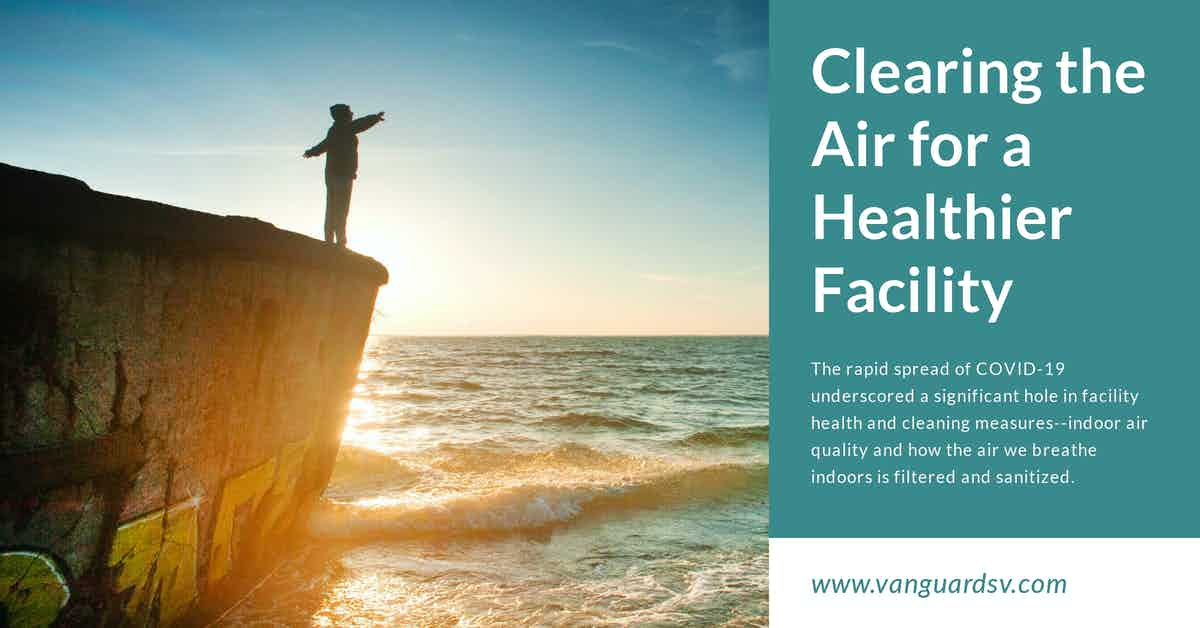The rapid spread of COVID-19 underscored a significant hole in facility health and cleaning measures--indoor air quality and how the air we breathe indoors is filtered and sanitized.

The Impact of Indoor Air Quality and Cleanliness on Occupant Health
Indoor air quality has a tremendous impact on occupant health and performance.
According to the Occupational Safety and Health Administration (OSHA);
The quality of indoor air inside offices, schools, and other workplaces is important not only for workers' comfort but also for their health.
Poor indoor air quality (IAQ) has been tied to symptoms like headaches, fatigue, trouble concentrating, and irritation of the eyes, nose, throat, and lungs.
Also, some specific diseases have been linked to specific air contaminants or indoor environments, like asthma with damp indoor environments.
In addition, some exposures, such as asbestos and radon, do not cause immediate symptoms but can lead to cancer after many years.
Numerous factors play a part in the quality of the indoor air, including:
- Exposure to industrial pollutants.
- Chemicals used indoors, including cleaning and disinfection products.
- Dust, pollen, and other airborne microbes.
- Building design, and;
- Ventilation systems and airflow--both natural and artificial.
In the past, maintaining high-quality indoor air consisted of two distinct methods:
- Increasing ventilation through the building using open windows or forced air systems, and;
- HEPA filtration systems in air ducts.
Both approaches have pros and cons depending on several external factors.
For example;
- Naturally ventilated facilities do not force air through HEPA filtration systems and can expose occupants to increased ozone levels in heavily polluted areas but can provide higher IAQ and conserve energy than mechanically ventilated facilities.
- Facilities with forced air systems, especially older ones, cost more to maintain and are subject to increased instances of sick building syndrome, but are far more practical in areas with high air pollution levels.
COVID-19 and the Future of Indoor Air Quality
The primary route of transmission for SARS-CoV-2 is presently believed to be via airborne particles.
The present course of social distancing and mask-wearing is likely impractical, long-term.
Realizing this, facilities managers have begun to assess HVAC systems and increased airflow as potential methods for combatting and preventing the spread of airborne pathogens.
Upon assessment, it was discovered that:
- Opening windows is impractical for most office workers where buildings are designed to be airtight to conserve energy and could pose safety issues for occupants, and;
- High-rated HEPA filtration systems that can capture airborne SARS-CoV-2 particles--MERV 13 and higher, reduce airflow through forced systems, resulting in decreased indoor air quality.
A promising addition to increasing indoor airflow and HEPA filtration are commercial-grade, four-stage air purification systems that boast a 99.7% airborne contaminant removal rating.
The most likely route, especially over the coming year, is to combine the three aforementioned methods with infection prevention and control methods that favor environmentally-preferable products, that:
- Provide the same level of protection as their more toxic counterparts.
- Tend to go lighter on the budget due to typically longer shelf-lives and the ability to ship and store the commercial-grade products in concentrated form.
- Are far less likely to result in poisoning and death as a result of over-exposure or accidental product mixture, and
- Release far fewer volatile organic compounds than comparable conventional commercial-grade products, and;
- Are far safer for the environment and facility occupants.
References & Resources
- Impact of indoor environmental quality on occupant well-being and comfort: A review of the literature
- Improve ventilation? Improve the air instead.
Takeaway
COVID-19 taught us a great deal about the methods we use to sanitize the spaces we live and work in, how that impacts our health, and the efficacy and long-term practicality of many methods previously considered rock solid.
Before the pandemic, the conversation regarding indoor air quality, its impact on occupant health, and methods for improving it had been picking up substantial speed.
Presently, it appears that implementing significant changes to building design going forward, combined with technologically advanced sanitation systems in forced-air systems, such as UV-C lighting and highly rated HEPA filtration, will be combined with additional four-stage commercial-grade air cleaning systems to eliminate airborne microbes and pathogens.
These steps must necessarily be combined with proven enhanced cleaning, training, and infection prevention and control methods to maximize facility occupants' protections.
Outsourcing is a proven method for ensuring the highest standards of cleanliness, safety, and training while controlling costs and eliminating management overhead.
If you would like more information regarding the effectiveness of high-performance infection prevention and control measures, or if you would like to schedule a free, no-obligation onsite assessment of your facility's custodial needs, contact us today for a free quote!
In Bakersfield, CA, call (661) 437-3253
In Fresno, CA, call (559) 206-1059
In Valencia CA, or Santa Clarita CA, call (661) 437-3253
In Palmdale, CA or Lancaster, CA, call (661) 371-4756

